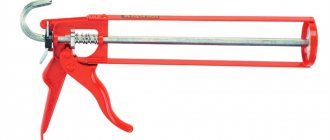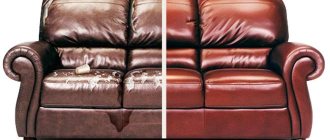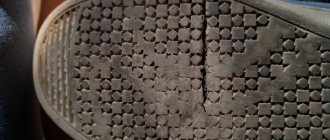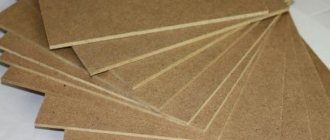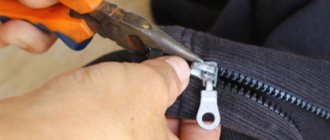Method 1: Mortise furniture nut and screw
If the hole did not fall out with chips when the self-tapping screw came off, you can drill it out and screw a furniture nut into it.
After this, the loop is installed on a screw instead of a self-tapping screw. This method is significantly stronger, since the mortise nuts have a larger grip area and therefore hold better.
Restoration of chips and scratches
At the ends and surfaces of countertops, especially at corners and radii, chips are not uncommon. They can be easily removed, especially if a melamine edge was used when processing the ends. For restoration, you will need to purchase new material for processing edges, preferably PVC, of the required length and color, from a specialized store that sells chipboard and furniture fittings. Using an iron or an industrial hair dryer, remove the old edge, clean the chipboard from chips with sandpaper and, while also warming it up, stick on a new one. Cut off excess edges with a utility knife and sand with fine-grained abrasive paper. Often, after installing the edge, traces of glue remain. They can be disguised with tinting.
Restoration of a dent on the end of the facade
If the chips, scratches and dents on the furniture are quite deep, they can be disguised as follows:
- Treat the defect, clean it from dirt and, using a chisel, give the recess a more or less rectangular shape.
- Choose furniture wax to match the chipboard. Sometimes you need to mix several different crayons to find the right shade, since you are unlikely to find the desired color in a pure color.
- Using a rubber spatula and softened wax, fill the recess and compact well.
- After the wax has hardened, you need to carefully cut off the excess using a utility knife or rubber spatula. The wax should be flush with the surface of the chipboard.
- Sand and polish the wax with a rag. If necessary, use retouching agents to restore the texture of the material. The final step will be to fix the result with a fixing varnish.
Related article:
How to remove scratches from furniture using: furniture pencil and stroke, wood wax and mastic, oil polish, using walnut kernels, nut oil, mayonnaise, tea leaves, machine oil, iodine, vinegar with vegetable oil, stain - in our publications.
Main door defects
The wardrobe, like any furniture, needs constant care. Otherwise, sooner or later problems appear that require drastic solutions. The metal parts of the interior also need care, as they can rust and begin to creak when the door is opened. Problems specific to furniture materials:
- Scratched door surface.
- The handle does not work or is broken.
- The door makes unpleasant sounds when it moves.
- The door does not close or does not fit tightly.
The most common problems with furniture hinges
Adjusting hinges involves properly tightening or loosening hinge components. It is worth remembering that each furniture hinge consists of several elements. These elements:
- The hinge tab is the unadjusted part of the hinge that is permanently screwed to moving doors or furniture fronts with two machine screws.
- The hinge fastening is the second part of the hinge (also screwed with two screws, but adjustable - fixing the height of the door), which is attached to the cabinet itself.
- Two adjusting screws – screws located on the mounting hinge; the first (located deeper in the closet) regulates the deviation of the door from the furniture, the second (located closer) is used to raise them.
The furniture hinge consists of three elements.
The most common problems with furniture hinges: the door falls off completely, the hinges are torn out by the roots, the fasteners have been deformed, manufacturing defects, frequent disassembly, loosening, improper fit. These problems can occur due to various reasons. From factory defects to poor-quality installation or wear. In this case, it is necessary to restore, strengthen, or simply replace the hinge with a new, durable and reliable option.
In case of problems, the mechanism is repaired or replaced.
What to do with the fittings
If the handle and lock are not of particular value, then they can be replaced. The rollers, with the help of which the canvas moves along the guides, are subject to both replacement and adjustment.
During long-term use of furniture, threads or dust collect in the grooves of aluminum profiles. This leads to poor web movement. In this case, repairing an old cabinet is simply removing the accumulated small debris or dirt.
The guides may not have a rigid fixation with the structure. To eliminate the defect, they are removed. The mounting location is determined, holes are drilled, and the profiles are attached to the furniture. Old holes are sealed with putty.
The reason for the door not closing tightly may be the deviation of the lower roller stopper. This problem can be solved by tapping the stopper with a light object. The stopper is moved into place. The door is closed for inspection. If it stays still and does not roll in the opposite direction, then the stopper is moved correctly.
The rollers may squeak. To eliminate unpleasant sound, they are lubricated with machine oil. You can also adjust the location of the rollers. When the bolt is screwed in, the blade rises slightly, and when unscrewed, it lowers.
Sometimes the rollers fail. Then they are changed:
- the lower and upper strips are unscrewed;
- the door is removed from the guides;
- the broken roller is unscrewed;
- the purchased roller is attached to the canvas.
How to fix broken cabinet doors
It’s worth noting right away that a number of defects can be corrected independently without any problems. For example, a common situation is creaking when opening/closing. Moreover, all doors creak, regardless of the material. The most unpleasant sounds are made by metal ones. In this case, it is not the cabinet that makes the sound, but the hinges, so they need to be repaired. You will need:
- oil. It is advisable to use special oil for hinges; machine oil can be used;
- syringe. There are no special requirements.
However, it is worth considering that there are some cases when replacing a hinge or door is much more profitable.
IMPORTANT FACT. As mentioned above, special hinge oil is a more necessary option, since it is sold in a special aerosol package.
The instructions for repairing the door are quite simple. It is enough just to coat the loop well; during this process it is advisable to open and close it once or twice so that the oil is better absorbed. However, if you have machine oil, then everything is a little more difficult. You will need a syringe. Almost anyone will do, including diabetics. You need to do all the same steps. Use only a few drops, otherwise the excess will end up at the bottom of the cabinet.
Cabinet Door Hinge Repair
Some problems with hinges can be solved on your own; in more complex situations, it is easier to replace them with new ones. When opening or closing a door, an unpleasant squeaking sound may appear from the door hinges. To fix the problem, you need to prepare a syringe and special oil for the loops (can be replaced with machine oil).
If the necessary equipment is at hand, then it will only take a couple of minutes to solve the problem, which can save the residents of the house from an unpleasant and annoying squeak. To do this, just take the oil into the syringe and thoroughly lubricate the loop, using just a couple of drops.
Possible causes of malfunctions
The reason for each malfunction has its own, let’s consider each one separately:
- If the door falls off, the load is too great for the hinge. The reason in this case may be weak screws or screws.
- If the hinges are completely torn out, then the depth for the screws was incorrectly calculated or the door is very heavy.
- When fasteners are deformed, peeling of the wood coating is most often observed. This occurs due to improper wood processing technology or wear of moving parts.
- Due to manufacturing defects, defective fasteners may result.
- If furniture is often disassembled and reassembled, then the holes in the seats may no longer hold the fasteners.
- If the doors are opened carelessly, loosening occurs. It can cause shifts and, as a result, deformation.
- The problem can also be caused by improper fit.
There may be several reasons for a malfunction.
Easy option
A quick method that even a fragile woman without the skills to work with tools can do. To restore the function of furniture you only need:
- PVA glue;
- several matches;
- hammer;
- rags;
- knife;
- sandpaper.
To begin with, I determine how many matches will tightly fill the hole, and begin the repair.
- I lubricate the recess and matches with PVA.
- I carefully hammer a bunch of matches into the channel from the screw.
- I wipe off the excess glue.
- The next day I split the matches with a knife and cut them to the level of the surface of the furniture wall.
- I level the surface with sandpaper.
- I screw in the screw.
The result of the activity will be almost the same as when installing a dowel.
Materials and tools needed for work
At the initial stage, furniture and necessary materials and tools should be prepared. The quality of the repair depends on this. After all, incorrect installation is fraught with loss of time and repeated work.
Preparation of products consists of wet cleaning and cleaning the surface of dirt. This procedure is carried out especially carefully if do-it-yourself cabinet repair involves the use of varnish.
The door needs to be removed. Check the quality of fittings and fasteners: hinges, handles, locks, bolts. Metal products are cleaned of rust and coated with an anti-corrosion agent. The wooden surface is sanded.
Depending on the material used to make the canvas, the following materials and tools will be needed to repair furniture at home:
- varnish;
- polyethylene film;
- machine oil;
- glue;
- putty;
- decorative material;
- accessories and fasteners;
- sandpaper;
- paint brush;
- syringe with needle;
- screwdriver;
- jigsaw;
- hex wrench;
- putty knife;
- Screwdriver Set;
- awl;
- pencil;
- roulette;
- square;
- level;
- hammer;
- pliers;
- chisel;
- plane;
- stationery knife.
Glue + sawdust
The solution is as old as time, and it should be noted that it works well. Perfect if you have a piece of chipboard torn out.
The idea is simple - we take sawdust (you can take it from a chipboard, a piece of which has been torn out), or find it near furniture factories, next to large construction supermarkets (usually there are pieces lying around that no one needs), crush them, mix them with glue (previously we used PVA) this Apply the mixture to the broken areas and let dry. And that’s it, tighten the “screws”. It's holding up well.
However, now there are a large number of adhesives; on the Internet I even saw a guy pouring a lot of glue from a glue gun into broken places. And everything seems to be holding up
I used to repair hinges in the kitchen a long time ago. BUT due to the fact that the sash was used often, it broke quite quickly.
So this is again an option for a while, for constant use (10 - 15 openings per day), this is not the best way.
Useful tips and tricks
When purchasing furniture, you should pay attention to specific sets of hinges in terms of their durability. Properly selected hinges help to open or close the door efficiently, and drawers will not get stuck on the guides. Hinges for kitchen furniture are used quite intensively, so it is necessary to choose reliable and durable options and not skimp on hinges.
Door hinges must be of high quality.
The exceptions are those found in rarely used furniture, such as a pantry. The most common problems with hinges are loosening or pulling. A broken hinge cannot hang in the same place where it was before. It should be moved 1-2 cm up or down. Changes should concern not only the door, but also the cabinet itself. Driving the screws should be preceded by creating delicate holes.
When the mechanism becomes loose, it needs to be moved to another location.
Installing hinges on the cabinet is necessary for self-assembly of furniture or in case of breakage of parts. This process does not take much time and is quite accessible even for inexperienced craftsmen. The only thing worth paying attention to is correct and clear labeling. The success of all subsequent actions and positive work results depend on this stage.
Repairing the hinge mechanism does not require much skill or experience.
When installing hinges, follow the instructions; when disassembling and restoring, take your time, let the materials dry well. Restored doors and high-quality installation of hinges can last a long time. If you choose complex fittings and have no idea how to install hinges, then it is best to contact a professional.
Please follow the instructions during installation.
When working, take your time, carefully measure each part of the fastener so that the markings coincide with an accuracy of 1 mm. If this is your first time doing installation or restoration, then watch the training lessons; they clearly show all the stages of these processes.
It is necessary to carefully mark the installation location.
Chipboard is characterized by problems with hinges, but they are easily solved. In order to solve the problem quickly, use the instructions and carefully follow each step you perform.
Installing hinges of a simple design does not require any special skills. They are easy to install if you follow each step step by step.
How to repair hinges on a cabinet door with your own hands
In order to repair hinges or install them, you will need special tools. Your arsenal should include:
- drill;
- screwdriver;
- metal drills;
- pliers;
- hammer;
- hacksaw;
- structure level, vertical;
- tape measure or ruler;
- pencil;
- hexagon.
For repairs you need to have certain tools.
You can eliminate the problem using glue, sawdust, epoxy resin, wood or metal dies, or purchase a new hinge.
Method 3: Cold welding for chipboard and self-tapping screw
If, when the loop breaks, part of the chipboard is torn out, then the lost surface can be restored by cold welding.
You need to fill the hole with it, and while it is fresh, tighten it and remove the screw. After the weld has set, it is twisted back into a loop.
magSpace.ru
Open registration
Useful tips
Live
Related Posts
IDA November 20, 2012, 6:34 pm
gennaddii November 17, 2015, 02:41
Axelerator February 26, 2015, 08:16
Awant 23 August 2014, 15:59
Skiminok 11 July 2013, 18:00
Top rated
Blogs
- Jokes and humor179367.98
- Interesting143442.27
- Unknown98305.46
- And again NEWS93635.13
- proGames69492.58
Mechanical damage to the door or handle
If there are deep scratches on the cabinet door, spoiling the beauty of the furniture, then there are only two options: restoration or complete replacement. As for the door handle, it is easier to replace it by purchasing a similar one or exactly the same one. To install a new handle, you need a screwdriver, which is used to perform the following procedure:
- Open the doors.
- Remove the screws.
- Remove the handle.
- Attach a new handle.
- Install the screws, but do not tighten them.
- Adjust the handle so that it takes the desired position.
- Tighten the screws.
How to repair an old chipboard cabinet, types of repair
Renewal, modernization, restoration of cabinet furniture involves different types of work, one way or another related to the repair and replacement of failed furniture components and parts. But all of the above repairs require a different approach, different costs and hand tools.
Repairing a cabinet made of chipboard means eliminating all faults in the form of sagging or torn-off facades, replacing torn out fittings on shelves and drawers. And also adjust hinges that are out of adjustment, tighten fasteners on loose sides, eliminate distortions and deflections on shelves and drawers. If this is a wardrobe, then door repair involves cleaning the guide tracks from debris, minor repairs or replacing jammed running parts and rollers. To do this, you will need ordinary hand tools for assembling furniture. And also, possibly, new hinges, guides to replace old ones that have failed. Based on the condition of the chipboard parts, you can make a decision - restore and update the existing ones or order new ones.
That is, the process of repairing a cabinet with your own hands can be accompanied by:
- Modernization of cabinet furniture. If during operation the shelves bend, the cabinet body becomes warped, and the drawers fall out of the guides, it is quite possible that the overall design will need to be changed and modified. At a minimum, add additional stiffeners and chipboard stops. In addition to additional parts for the cabinet, you will need to purchase fasteners for them (confirmations, screws, corners) and prepare a tool for drilling new holes.
- Replacement of fittings and fasteners. For example, you bought an inexpensive cabinet and discovered that the quality of the hinges on the doors and the guides on the drawers leaves much to be desired. Moving elements creak, jam and irritate with knocking. You can easily purchase hinges with closers or higher quality guides of the same type from good brands (Blum, Hetikh, Boyard, etc.) and replace them yourself using a screwdriver and a screwdriver.
- Restoration and complete replacement of front and internal parts. If the front surface of the chipboard or the ends of the furniture are damaged, additional funds will be required for restoration. Deep scratches and recesses from torn fasteners are filled with different compounds, sanded and masked using various furniture chalks, pastes, and markers. The edge can be re-glued onto the end restored to its shape. Or you can completely replace the façade or update it by painting.
New loop
You can get out of this situation in another way - you don’t need to glue anything. Door hinges now come in a variety of sizes and with different distances between screw holes. In this case, you don’t even have to seal the holes from the fallen fasteners.
It is better, of course, to do this by covering it with furniture wax - any unnecessary hole reduces the strength of the entire structure. So seal the holes using one of the suggested methods, and then proceed as follows:
- Using a special cutter with a diameter of 30 mm, make grooves in the door for the hinge higher or lower than before.
- Screw the hinge to the door with self-tapping screws.
- Screw the second part of the loop to the side.
Important! For greater reliability, you can immediately place the screws on the glue - this will increase the strength of the fastening.
Wooden “chopik” + glue
I think this method is the best. After such a repair, the door in my kitchen worked for several years, and nothing was torn out again.
The principle is this: Remove the sash - door, then you need to take a drill and drill out the torn holes.
We take a drill with a diameter slightly smaller than a wooden “chopik”, for example, my chopstick is 9 mm in diameter, and the drill is 8 mm.
We do not drill to the full depth of the door, usually 80% is enough, the main thing is not to drill further, because the drill will come out on the other side of the door, which is not always necessary. To do this, there is a special limiter on the drill, or at the required depth, you need to screw electrical tape onto the drill and not go beyond its limits.
Next we pour glue into the hole, I take “MOMENT” which glues the wood (you can take any other one; there are now dozens of different ones). Well, we hammer in the “chopik”, do it carefully so as not to break the back wall!
Let it set for about 15 minutes. Then in our wooden inserts, I drill another hole in the center, also not to the full depth. This is done in order to tighten the “screw” freely, but do not overdo it. For example, I have a “screw” with a diameter of 4 mm, and I take a drill with a diameter of 2 mm.
I tighten it on the removed door, try it - it holds perfectly! Now you can hang it on the closet .
This third method, I think, is the best for repairing chipboard doors. Moreover, it is suitable for frequent openings.
Now we are watching the video version
This is where I end, I think my materials were useful to you. Read our construction blog, there will be a lot more useful.
Ways to strengthen furniture hinges
If a furniture hinge has become loose, it must be strengthened so that it continues to serve. How to strengthen hinges on a cabinet door:
- Insert a drill into the holes for furniture screws and drill them out. Be careful not to make a through hole. Drills of sizes 5 and 10 mm are suitable.
- We take a stick and make several chopsticks of the same size with drilled holes out of it.
- Fill the holes and holes with glue. Then we kill them and leave them for 24 hours.
- We insert the loop and make marks where it will now be located.
- After which the loop is put in place and re-screwed.
A loose loop can be strengthened.
Method 7: Cotton wool and wood glue
When the torn self-tapping screw comes out neatly, without leaving a wide crater, the hole can be drilled out a little.
Then cotton wool mixed with wood glue or regular PVA is pressed into it.
When the mixture dries, you can screw the screw into it.

